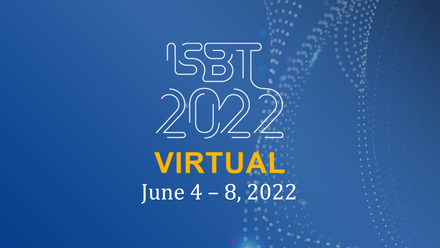The Diving deep into blood groups session included the following presentations:
1. Vanja Karamatic Crew: The new Er blood group system: Piezo and its role in RBC physiology
2. Gloria Wu: Elucidating the Blood Group Regulome
3. Camous Moslemi: A deep learning approach to the genetic prediction of blood group antigens
4. Gian-Andri Thun: Intriguing outcomes from Nanopore sequencing of two cryptic A3 samples: a case of blood group mosaicism and a novel regulatory variant in the ABO system
MODERATORS: Catherine Hyland and Frederik Banch Clausen
After the presentation, there was a questions and answers session of about 5 minutes, which is also included in the recording.
Abstract
Intriguing outcomes from Nanopore sequencing of two cryptic A3 samples: A case of blood group mosaicism and a novel regulatory variant in the ABO system
G Thun1, M Gueuning1, C Engström2, E Gourri1,3, S Sigurdardottir3, L Schneider3, E Meyer3, J Sigle4, B Frey1,2,3, S Meyer3, M Mattle-Greminger1
1Department of Research and Development, 2Department of Immunohematology, 3Department of Molecular Diagnostics and Cytometry, Blood Transfusion Service Zurich, Schlieren, 4Blood Transfusion Center Aargau-Solothurn, Aarau, Switzerland
Background: Mixed-field agglutination (MFA) in ABO phenotyping (A3,B3), that is, when two separable cell populations are present in agglutination tests with anti-A or anti-B, is mostly linked to rare variants in ABO exon 7 and regulatory regions. Alternatively, MFA could be observed because of chimerism (cells derived from different zygotes, e.g., due to bone marrow transplantation) or, in exceedingly rare cases, true mosaicism (genetically different cell lines derived from the same zygote, e.g., due to somatic mutations in stem cells). Elucidating the genetic cause of MFA is technologically challenging. Incomplete knowledge about regulatory regions further hinders resolving unexplained cryptic ABO phenotypes. Latest long-read sequencing has great potential in this regard by enabling complete gene haplotype sequencing to a high read depth, even allowing the detection of subclonal variants at low variant allele frequencies (VAFs).
Aims: We used long-read sequencing by Oxford Nanopore Technologies (ONT) to resolve two cases with cryptic ABO phenotypes (A3 and A3B, respectively).
Methods: ABO phenotypes were determined by standard serological methods, including anti-A1 and anti-H specific agglutination. PCR-SSP kits (inno-train, Germany) were used for ABO genotyping. Expression of A-, B- and H-antigen was measured by flow cytometry. The entire ABO gene was amplified by two overlapping long-range PCR fragments of ~13 kb each. PCR-products were sequenced with ONT on a MinION flow cell to a read depth >1000×. Result confirmation was derived from multiple lines of evidence, including analysis of presence of chimerism and mosaicism by digital PCR (STILLA, France), Sanger sequencing of the region of interest, and family analysis where applicable.
Results: Blood cells of the first case, genotyped AO1 and presenting A-antigen on ~80% of erythrocytes, showed strong reactions with anti-A1 and anti-H, pointing to very distinct cell populations. Nanopore sequencing depicted a subclonal 3-bp insertion in exon 6 (VAF ~10%). The variant was only present on ABO*A haplotypes and translated into a frameshift (Tyr126Ilefs*69) causing a null phenotype in the affected cells. Allele-specific Sanger sequencing confirmed the insertion and no chimerism was detected. Instead, we suggest the uncommon case of mosaicism as a digital PCR approach quantified VAF at ~14% and a blood sample donated 10 months later pointed to a robustly affected cell proportion (VAF ~17%). The second case, a A3B sample, showed weak and absent agglutination with anti-H and anti-A1, respectively. Almost 60% of erythrocytes carried only B antigen. Nanopore sequencing revealed a novel heterozygous g.10924C>A variant phased to the ABO*A-allele in a known transcription factor binding site for RUNX1 in intron 1 (+5.8 kb site). Sanger sequencing confirmed this variant, and its inheritance was proven by analysing the donor's mother, who shared the anti-A MFA.
Summary/Conclusions: Here, we disclose an exceptional case of genetic ABO mosaicism presumably arising from a somatic indel mutation in a hematopoietic stem cell before its division into myeloid and lymphoid progenitor cells. The second reported case of MFA was resolved by the discovery of a regulatory variant in the 8-bp RUNX1 motif of ABO, extending current knowledge of four other variants affecting the same motif and also leading to A3 or B3 phenotypes. Overall, long-range PCR combined with ONT sequencing proved powerful for the resolution of both ABO MFA cases.
















